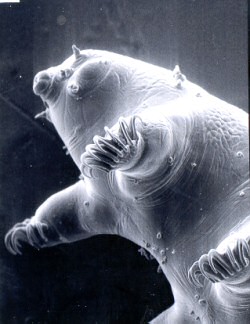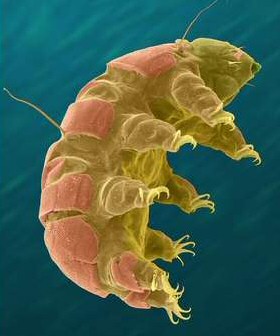The tardigrade, champion of survival!
The tardigrade is a small ubiquitous animal not exceeding 2 mm, which represents a branch in itself as its classification poses problems for biologists, it would currently be linked to the branch of arthropods. Several species are currently known.

It is a freshwater species which various studies have shown amazing results that allow us to grant it to date the hotly contested title superchampion Animal resistance.
Indeed, under very unfavorable conditions, it is capable of emptying itself of its water, of mummifying in a way, and passing into cryptobiosis. In an almost absolute state of anhydrobiosis, it almost completely suspends its metabolism to the point that the most powerful tools we have now, can not detect any traces.
The tardigrade in cryptobiosis takes the shape of a very compact barrel (almost opaque under the microscope) which allows it to reduce its evaporation surface and thus to limit water losses which could be fatal to organelles which are very sensitive to desiccation. The animal then produces a sugar which takes the place of the water in its body which makes it possible to limit the deterioration of the membranes sufficiently so that they can be repaired during rehydration. This phenomenon also exists in a toad and a snow squirrel, which produce a kind of glycerol which replaces their water and which acts as an antifreeze. We know that it is the ice crystals that form during freezing that damage cell membranes, damaging the cell.
The compound which takes the place of water does not form crystals and allows the cell to survive freezing Only rotifers, nematodes (which encyst), some insects and crustaceans are capable, like the tardigrade to enter cryptobiosis. The tardigrade can maintain this quiescent state for centuries or even millennia, before conditions become favorable again and he miraculously regains life.
Exceptional “survival” capacities
Tardigrade specimens were discovered in an ice cap estimated to be over 2000 years old and have come back to life.This form of resistance not only to suspend the course of time but also to survive the attacks of the extreme temperatures and many chemicals.
It can indeed withstand enormous thermal amplitudes, exposures to -272,9 ° C for 20 hours, or in liquefied air at -190 ° C for 25 months, or on the contrary to temperatures above more than 150 ° c they survive without problem in absolute vacuum, or, conversely, at a hydrostatic pressure of 600 megapascals, i.e. 6 times the pressure exerted at the bottom of the ocean at -10 meters deep or 000 times the atmospheric pressure , whereas, normally, from 30 megapascals, that is to say a pressure exerted at a depth of 3000 m or 300 times the atmospheric pressure, cell membranes, proteins and DNA undergo irreversible damage.
They are also resistant to extremely harsh ionizing radiation (ultraviolet, etc.) but also to X-ray bombardments as well as toxic chemicals and poisons that would inevitably have most organisms of its size. Moreover, in this area the tardigrade is far from having revealed all its secrets.
As we have seen, the tardigrade is an animal over-equipped to withstand anything, it is even over-adapted.
Some animals are known to live in extreme environments, such as riftias or thermophilic bacteria, for example, living in close vicinity of hydrothermal vents, under temperatures and enormous pressure.
Ice worms, on the other hand, can withstand extreme cold and a very low portion of oxygen. These animals have managed to adapt to these extreme environments only through a very long and very sensitive evolutionary process. This adaptation is so fine and so elaborate that the organisms which benefit from it are very sensitive to even slight variations in its environment. They are generally adapted very effectively to the conditions of their environment but not at all to the conditions at the opposite extreme.
The cold, the heat, the lack or absence of o2, the presence of co2, the lack of water, nutrients, the presence of toxic substances, all these conditions unfavorable to life, have given rise to organisms that have managed to adapt specifically to these. However, specific adaptation, although very effective and necessarily well developed, cannot allow the organisms which have developed it to withstand living conditions different from those of their respective biotope, due to the specificity of their adaptation. This ties in with the Darwinian concept according to which the most developed and best adapted ecological niches are also the most fragile. Specific adaptation is subject to the eternal compromises of life, in one way it is very effective and in another it is very restricted for the same reasons. Compromise seems to be a great dogma of life, in which every advantage granted is associated with a disadvantage.
The tardigrade meanwhile seems to escape these inevitable compromises. The extreme conditions that we have mentioned above seem very unfavorable to life, but none seems incompatible with the survival of tardigrade.

A more philosophical approach
The tardigrade is therefore able to withstand conditions that we do not even meet on earth, where ultimately they seem lenient on the scale of those that we encounter elsewhere in the universe. Nature never does anything to chance, we can then wonder what use it to be so resistant, since on earth it is truly over-equipped. How could natural selection act on the characteristics of the tardigrade to allow it to retain attributes that it could not test?
Natural selection by its selective action tends to conserve all the variations which appear useful to the animal, but for its action to be effective, it is also necessary that these variations can be tested by the conditions of an environment and that they have some advantage. The tardigrade is resistant to conditions that cannot be encountered on earth, so either natural selection has caused it to retain these extreme characteristics without being able to actually select them, assuming that overfitting cannot be unfavorable to it. 'animal. Either natural selection has retained only some of its characteristics which are essential to it, and these super-resistances would have been preserved only by chance.
One can also think that the tardigrade would undergoes natural selection other than on earth where extreme conditions it is resistant meet.
This reality has prompted some biologists to advance the hypothesis that the provenance of tardigrade could be outside the terrestrial globe.

The hypothesis of the extraterrestrial origin of the tardigrade. Be that as it may and whatever its origin, the tardigrade still remains a gifted animal of adaptation, an exceptional organism which still has many secrets to share with us and of which we currently only have very little information compared to the interest it can arouse within the scientific community. It alone shows the infinite power of nature to design extraordinary living beings of ingenuity, diversity, and adaptability to all the conditions that the laws of physics and chemistry have imposed on the universe.


The resistance to desiccation of Tardigrade explained by science: https://www.econologie.com/forums/sciences-et-technologies/le-tardigrade-resistance-extreme-et-cryptobiose-t12339-30.html#p317713